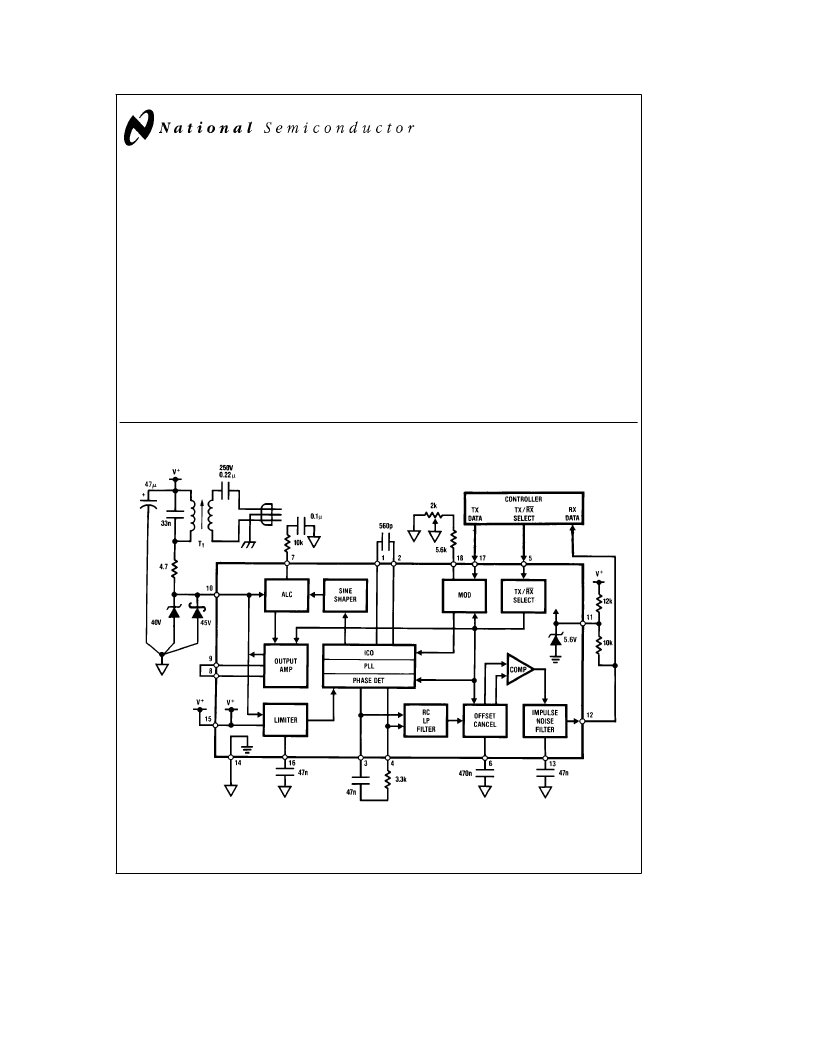- 您現在的位置:買賣IC網 > PDF目錄385479 > LM1893 (National Semiconductor Corporation) LM1893/LM2893 Carrier-Current Transceiver PDF資料下載
參數資料
| 型號: | LM1893 |
| 廠商: | National Semiconductor Corporation |
| 英文描述: | LM1893/LM2893 Carrier-Current Transceiver |
| 中文描述: | LM1893/LM2893載波電流收發器 |
| 文件頁數: | 1/24頁 |
| 文件大?。?/td> | 576K |
| 代理商: | LM1893 |

TL/H/6750
L
April 1995
LM1893/LM2893 Carrier-Current Transceiver
2
General Description
Carrier-current systems use the power mains to transfer in-
formation between remote locations. This bipolar carrier-
current chip performs as a power line interface for half-du-
plex (bi-directional) communication of serial bit streams of
virtually any coding. In transmission, a sinusoidal carrier is
FSK modulated and impressed on most any power line via a
rugged on-chip driver. In reception, a PLL-based demodula-
tor and impulse noise filter combine to give maximum range.
A complete system may consist of the LM1893, a COPS
TM
controller, and discrete components.
Features
Y
Noise resistant FSK modulation
Y
User-selected impulse noise filtering
Y
Up to 4.8 kBaud data transmission rate
Y
Strings of 0’s or 1’s in data allowed
Y
Sinusoidal line drive for low RFI
Y
Output power easily boosted 10-fold
Y
50 to 300 kHz carrier frequency choice
Y
TTL and MOS compatible digital levels
Y
Regulated voltage to power logic
Y
Drives all conventional power lines
Applications
Y
Energy management systems
Y
Home convenience control
Y
Inter-office communication
Y
Appliance control
Y
Fire alarm systems
Y
Security systems
Y
Telemetry
Y
Computer terminal interface
Typical Application
TL/H/6750–1
FIGURE 1. Block diagram of carrierDcurrent chip with a complement of discrete components making a complete
F
O
e
125 kHz, f
DATA
e
360 Baud transceiver. Use caution with this circuitDdangerous line voltage is present.
BI-LINE
TM
and COPS
TM
are trademarks of National Semiconductor Corp.
2
Carrier-Current Transceivers are also called Power Line Carrier (PLC) transceivers.
C
1995 National Semiconductor Corporation
RRD-B30M115/Printed in U. S. A.
相關PDF資料 |
PDF描述 |
|---|---|
| LM1893N | RES 250K-OHM 1% 0.125W THICK-FILM SMD-0805 5K/REEL-7IN-PA |
| LM2893M | LM1893/LM2893 Carrier-Current Transceiver |
| LM2893N | LM1893/LM2893 Carrier-Current Transceiver |
| LM2895 | AUDIO POWE RAMPLIFIER |
| LM1895 | AUDIO POWE RAMPLIFIER |
相關代理商/技術參數 |
參數描述 |
|---|---|
| LM1893 WAF | 制造商:Texas Instruments 功能描述: |
| LM1893N | 制造商:NSC 制造商全稱:National Semiconductor 功能描述:LM1893/LM2893 Carrier-Current Transceiver |
| LM1893N/A+ | 制造商:未知廠家 制造商全稱:未知廠家 功能描述:Carrier/Multi-Wire Interface |
| LM1893N/B+ | 制造商:未知廠家 制造商全稱:未知廠家 功能描述:Carrier/Multi-Wire Interface |
| LM1894 | 制造商:NSC 制造商全稱:National Semiconductor 功能描述:Dynamic Noise Reduction System DNR |
發布緊急采購,3分鐘左右您將得到回復。